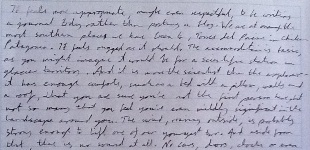
- Doctors aspire to this level of illegibility
Sometimes an iPad is plain inappropriate. Sitting in the dining room of our hostel in the Laguna Amarga in the Torre del Paine glacier park in Chile is one such time. In fact, anything with a microprocessor in it. Or indeed that connects
to… Well, anything that connects. The view looks so stark, so untouched (though it has been), so pristine and so savagely natural that to defile it with technology feels abusive. And so, for the first time in decades, I started
to write a journal. Not post a blog, but write with pen purloined from a British Airways 747 on paper stolen from my children’s notepads. It didn’t last long, of course. My fingers gave up after a (short) while, and here we are
back on the inappropriate.
The local books are resplendent with pictures of the early explorers of this territory. Walking around the grasslands here, you can’t help but feel the spirit of those first explorers, and in those same pictures, the scenery in those
days in the early 1900s does not look so different from how it looks today. Of course, even our rudimentary hostel is unimaginably luxurious next to their accomodation as they travelled through, but somehow still here in Chile
the spirit of those early days seems to be present. That’s not to mention that much of the discovery of the large tracts of the Southern Patagonia Ice Field, which covers most of this park, was still ongoing in the last 20 years.
[album: https://oursouthamericablog.com/wp-content/plugins/dm-albums/dm-albums.php?currdir=/wp-content/uploads/dm-albums/Laguna Marga Hostel/]
I was looking forward to Chile for my own obscure reason. For some bizarre reason, the largest community of Palestinian exiles outside of the Middle East is all the way across in this most southern of South American countries. The
community had started in the 1920s and 1930s, accelerating after 1948 when many mainly Christian Palestinians expelled by the creation and advance of Israel ended up here following the earlier exiles. Today, they number about 450,000.
So it was only natural that when we went into Chile, I looked for and found a community of expats. In a sad indictment of my ineptitude, though, they happened to be Croatian expats.
[album: https://oursouthamericablog.com/wp-content/plugins/dm-albums/dm-albums.php?currdir=/wp-content/uploads/dm-albums/Random Torres del Paine/]
Our seventy two year old host, Juan, of Croatian parents like many of the homesteaders in this area, has made the most of not very much. He was incredibly proud of the bricks that were used to build his hostel, ensuring that he showed
me the English ‘Andrews Glasgow’ (ahem) bricks by the furnace. The photos of the area in the most popular local book were taken by another immigrant, a Swiss photographer. And his stories of the many people in the area, none of
whom seemed to have been more than 2 generations Chilean, only reinforced the impression of this place as frontier territory. (No less opportunistic was the fleecing to be had exchanging between any currencies here).

Inauspicious sign welcoming the 1.2 cars that come across here daily
We drove across into Chile from Argentina at Cerro Castillo. It is great to drive across a border where you are one of only 2 cars making the crossing. There was a fun gravel drive between the Argentine and Chilean borders, and you
can see with the emptiness of the landscape quite how contorted the very heated border discussions between the two countries must have been to try to define a natural line. After a brief fleecing with obscenely loaded currency
exchange rates, we move on.
[album: https://oursouthamericablog.com/wp-content/plugins/dm-albums/dm-albums.php?currdir=/wp-content/uploads/dm-albums/Chilean Shrubbery/]
We spend most of our time here driving around in our rented 4×4 Hyundai. Even among the steep hills and gravel roads of Chilean Patagonia, I don’t have the need to use it in 4×4 mode, so quite what 4x4s are doing in Chelsea is beyond
me. The lakes, forests, mountains and glaciers make spectacular backdrops for driving through. The roads are crossed often by Guanacos (relatives of the llama) and Darwin’s Rheas (ostrich like birds). The boys have a great time
repeatedly making up nonsensical “why did the ostrich cross the road?” jokes.
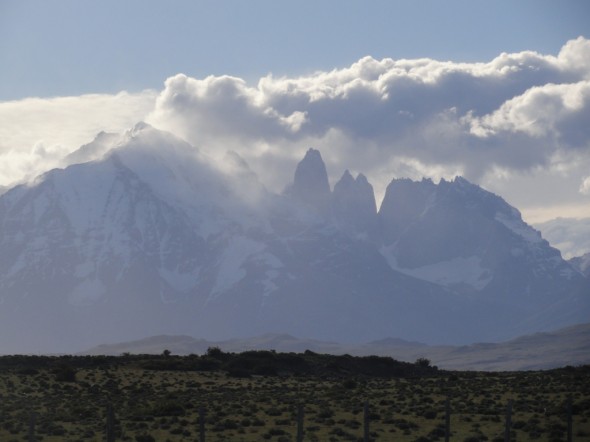
- Our first sighting of the Torres
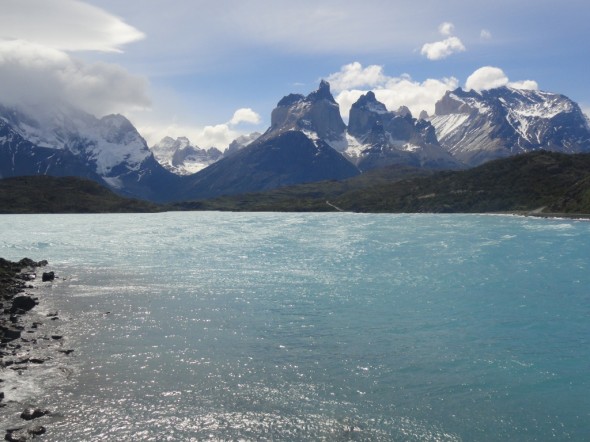
- Torres on a clearer day
We are somewhat restricted from hiking the vast half million acres of this park as it would be more difficult than we would enjoy to take the youngest around, and the wind if fierce. The towers which lend their names to the place are
three granite peaks, visible dramatically from most areas of the park. The scale of the place does mean that when you drive through it, you feel pretty solitary, seeing other cars no more than once every half hour or so. Solitary,
that is, if you can block out the shouts of four children in the back.
[album: https://oursouthamericablog.com/wp-content/plugins/dm-albums/dm-albums.php?currdir=/wp-content/uploads/dm-albums/Windy Salto Grande/]
The most prominent feature of the weather while we are in Chile is the wind. The strength of it buffets the car repeatedly, and we have to be careful to only open one door at a time if we’re not to lose papers and books from the car.
As we admire the view of the falls at Salto Grande, we all duck whenever the wind gets stronger so as not to get blown over, and Paola and I have to hold the two little ones in our arms so as not to lose them. But the view doesn’t
disappoint. As the water canons down the falls, it exerts a strong gravitational pull, and leaves you no room for doubt about for the ferocious power of the water that gushes from the glaciers. We leave as the heavily set bikers
who have come down in full leathers seem to be struggling with the now frequent gusts.

Cascadas Paine from Above

Cascadas Paine Face to Face
[album: https://oursouthamericablog.com/wp-content/plugins/dm-albums/dm-albums.php?currdir=/wp-content/uploads/dm-albums/Cascadas Paine/]
If it’s not a glacier view, it’s a view of the Torres. If it’s not a view of the Torres, it’s a view of extremely fast rivers and falls. And the latter are so strong that they provide an excellent example of everything we studied as
kids about rivers and erosion. As we pull into Cascadas Paine, I run down the bank to get close to the river, running so as to avoid the gaze of my youngest who would doubtless want to join me. Paola is not convinced that a man
with my dexterity (or lack of) should be going down, let alone taking the two eldest boys as I did after I saw how achievable it was. They obviously bounced both down and up the bank in a fashion that left Dad breathless. However,
at the bottom, we did get to see a close-up of how the river was eating away at the striated rock in the middle of the stream, and I just hope Omar remembers it in 5 years’ time when he sits his Geography GCSE.

Caveman and Milodon
[album: https://oursouthamericablog.com/wp-content/plugins/dm-albums/dm-albums.php?currdir=/wp-content/uploads/dm-albums/Milodon Cave/]
As I hope they all remember the impressively large Milodon Cave. This cave was cohabited by humans and milodons about a half dozen thousand years ago. The milodon, of which there was a 4 metre high life-size replica at the mouth of
the cave, was a (thankfully for the humans) herbivorous mammal, also known as a giant sloth. With not too much imagination, you can easily picture a pre-historic scene of the inhabitants here (with or without a barely fur-clad
Raquel Welch).

Looking along the bridge to the island

View of hotel and bridge from mainland
[album: https://oursouthamericablog.com/wp-content/plugins/dm-albums/dm-albums.php?currdir=/wp-content/uploads/dm-albums/Pehoe/]

Bridge as Dali might have seen it
Our last port of call before leaving Chile is a rather plush hotel at the Laguna Gris, the Hosteria Lago Grey. The children were incredibly
well looked after by one of the best hotel barmen I’ve met, who found the perfect balance between being friendly and helpful, yet remaining unobtrusive. The four of them sat on barstools munching pistachio nuts (which he was peeling
for them) is a sight I hope not to see replicated for at least another 15 years. The hotel sits overlooking a beach at the foot of the Grey glacier, and has a dramatic view over the beach to the lake and glacier. The lake is garnished
by near flourescent blue icebergs floating like massive ice sculptures, with the backdrop of the glacier flowing down in a chicane between huge mountains. Sitting in the bar sipping cuba libre on the rocks was a suitable ending
to the visit, feeling as it did that we had in our drink created a minuscule and somewhat ridiculous replica of the view ahead. Fitting in that here in Patagonia, you do realise how minuscule and ridiculously small you are next
to the vastness of nature.

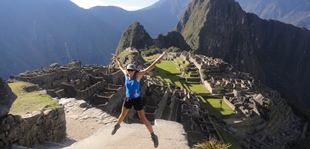
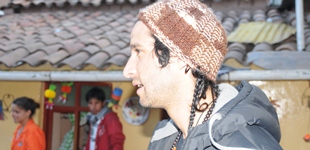

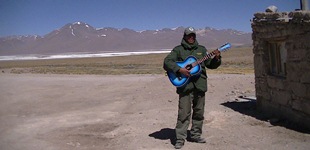






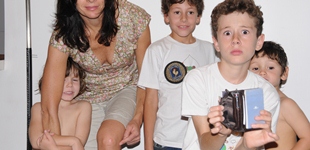

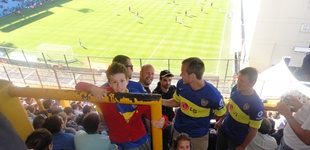


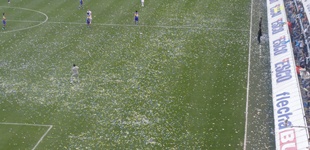










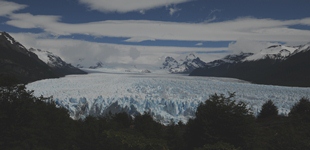
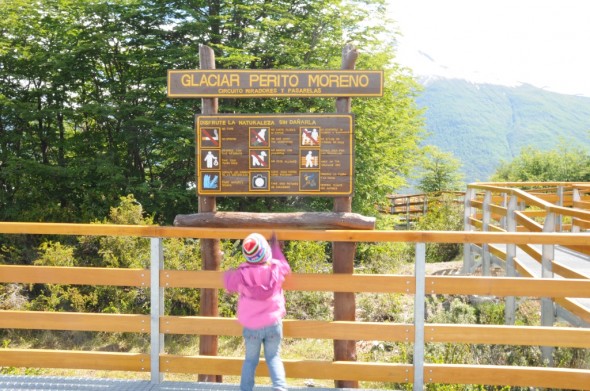

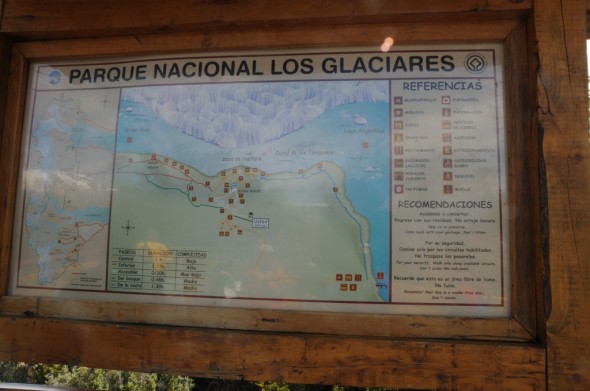

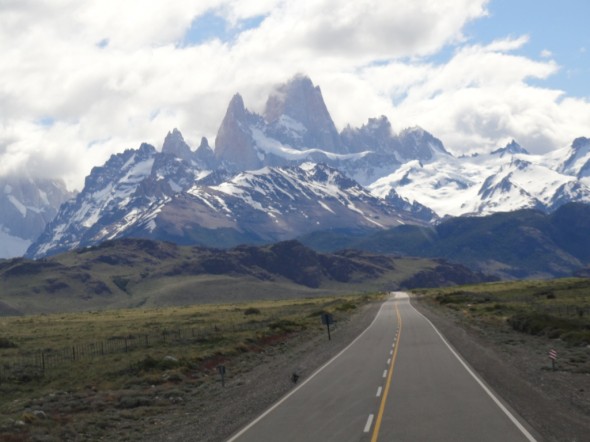
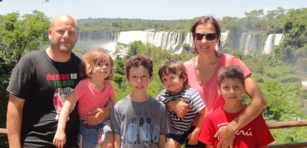

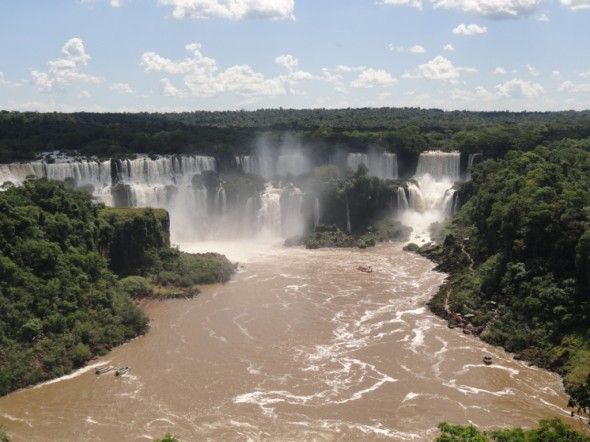

Impresionante Mirentxu! que maravilla, eso si que es tocar las nubes!!! nunca deja de sorprenderme tu valentia y energia! Orgullo de amiga!! Te quiero mucho! keep safe xx
Hola Paola!
Way to go, girl!! Os echo de menos y me acuerdo muchísimo de vosotros todos los días. Fue un regalo conoceros y tener la oportunidad de disfrutar unos días contigo y con tu familia.
Con todo el amor,
Rebeca
Ole la Mare que te pario!! Peaso de viaje tia! Que chulo, me encanta el contraste de nieve y calor tropical. Y una curiosidad, pa mea y caga, eh????!!!